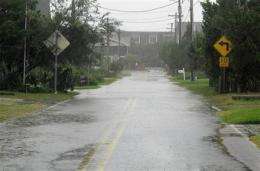Worry more about Irene's water than storm's wind

(AP) -- Forget the wind and fury. Hurricane Irene's most worrisome weapon is water.
There's just way too much of it: storm surge pushing seawater ashore and heavy rainfall causing flooding. That's not unusual with hurricanes, but with Irene there are a couple of added factors that are making meteorologists nervous.
This massive, slow-moving hurricane is forecast to soak an already drenched Northeast and may come ashore at a time when tides are unusually high, making storm surge even worse - 4 to 11 feet with waves on top, forecasters say.
"Water is the No. 1 killer," retired National Hurricane Center Director Max Mayfield said Friday afternoon. "That's going to cause the greatest loss of life."
Many deaths can be avoided if people leave the coast and don't drive into flooded areas, he said.
MIT meteorology professor Kerry Emanuel said the flooding from Irene could be worse than the 1938 New England hurricane that killed 564 people.
"I think everybody is confident, unfortunately, that this is going to be a bad event from freshwater flooding," he said.
Forecasters predict Irene will dump 6 to 10 inches of rain in a swath from North Carolina to New England with some areas getting as much as 15 inches of rain. That's partly because the storm is unusually large and is moving fairly slowly - around 15 mph - allowing it to dump more rain over large areas.
"And all of this rain will come in a short period of time, and that could lead to life-threatening flash floods," National Hurricane Center meteorologist John Cangialosi said Friday.
Much of the area on Irene's projected track from Baltimore to New England is already soaked from higher than normal rainfall in the past month. Philadelphia has already had about 13 inches this month, which Cangialosi called "extraordinary."
When a hurricane comes ashore, it brings with it steadily rising seawater, called storm surge. With waves and wind, it pushes inland along rivers, bays and sounds in addition to the beachfront.
National Weather Service storm surge models - using a computer program called SLOSH - show Irene could bring about 4 feet of water into New York City's Battery Park at the tip of Manhattan, Emanuel said. The forecast has Irene heading east of New York; it could be far worse if Irene hits just west of the city, he said.
In some places, the storm surge projections are higher. Water levels may rise as much as 6 to 11 feet on North Carolina's Outer Banks, Cangialosi said.
As Irene makes its way up the coast from the mid-Atlantic to the New Jersey shore, the best projections suggest Irene's center will stay just to the east offshore, he said. So the surge may be slightly lower there, about 4 to 8 feet in the southern Chesapeake Bay area and 3 to 6 feet along the Jersey shore.
But there's another added problem with storm surge: The tides.
Twice a month, tides are higher than normal because the gravitational pull of the moon and sun occur at the same time. That's happening with the new moon on Monday. That means about half a foot difference in low and high tides Sunday, said Stephen Gill, a scientist with the National Oceanic and Atmospheric Administration.
"It's going to be bad no matter what and it's going to be worse if it hits at high tide," Gill said
And that's not all. An experimental science program shows Irene's unusual size means it would produce much more of a storm surge punch than a hurricane with the same wind speeds, said NOAA atmospheric scientist Mark Powell.
More information:
The National Hurricane Center: http://www.nhc.noaa.gov
Storm surge: http://www.nhc.noaa.gov/surge/
The 1938 Great New England Hurricane: http://1.usa.gov/n0vL0E
©2011 The Associated Press. All rights reserved. This material may not be published, broadcast, rewritten or redistributed.

















